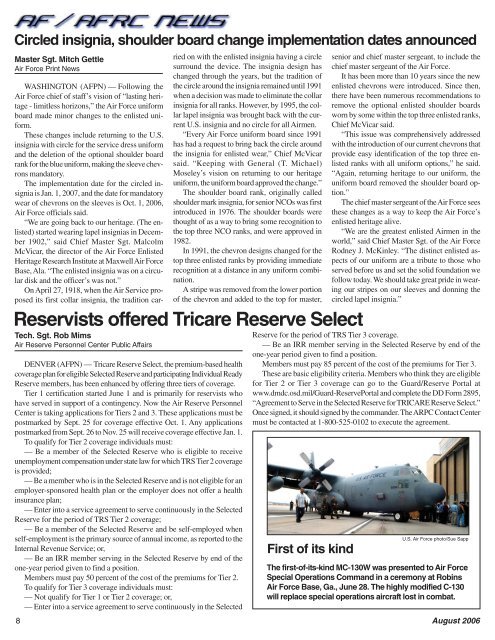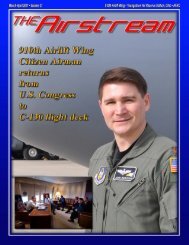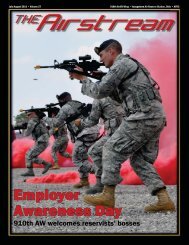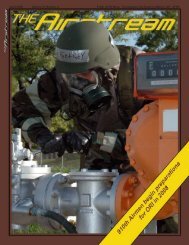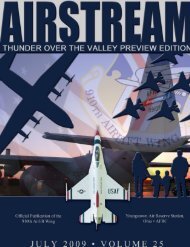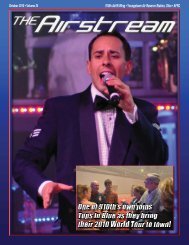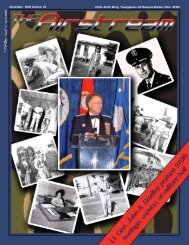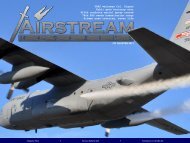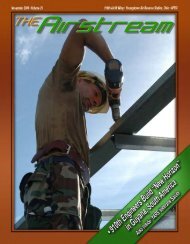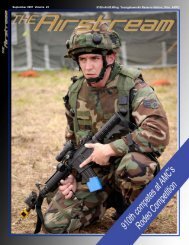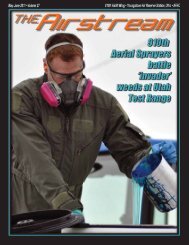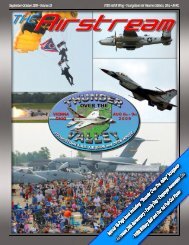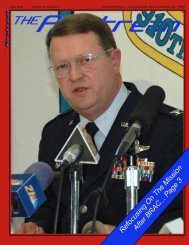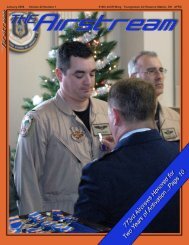August - Youngstown Air Reserve Station
August - Youngstown Air Reserve Station
August - Youngstown Air Reserve Station
Create successful ePaper yourself
Turn your PDF publications into a flip-book with our unique Google optimized e-Paper software.
Circled insignia, shoulder board change implementation dates announced<br />
Master Sgt. Mitch Gettle<br />
<strong>Air</strong> Force Print News<br />
Reservists offered Tricare <strong>Reserve</strong> Select<br />
Tech. Sgt. Rob Mims<br />
<strong>Air</strong> <strong>Reserve</strong> Personnel Center Public Affairs<br />
DENVER (AFPN) — Tricare <strong>Reserve</strong> Select, the premium-based health<br />
coverage plan for eligible Selected <strong>Reserve</strong> and participating Individual Ready<br />
<strong>Reserve</strong> members, has been enhanced by offering three tiers of coverage.<br />
Tier 1 certification started June 1 and is primarily for reservists who<br />
have served in support of a contingency. Now the <strong>Air</strong> <strong>Reserve</strong> Personnel<br />
Center is taking applications for Tiers 2 and 3. These applications must be<br />
postmarked by Sept. 25 for coverage effective Oct. 1. Any applications<br />
postmarked from Sept. 26 to Nov. 25 will receive coverage effective Jan. 1.<br />
To qualify for Tier 2 coverage individuals must:<br />
— Be a member of the Selected <strong>Reserve</strong> who is eligible to receive<br />
unemployment compensation under state law for which TRS Tier 2 coverage<br />
is provided;<br />
— Be a member who is in the Selected <strong>Reserve</strong> and is not eligible for an<br />
employer-sponsored health plan or the employer does not offer a health<br />
insurance plan;<br />
— Enter into a service agreement to serve continuously in the Selected<br />
<strong>Reserve</strong> for the period of TRS Tier 2 coverage;<br />
— Be a member of the Selected <strong>Reserve</strong> and be self-employed when<br />
self-employment is the primary source of annual income, as reported to the<br />
Internal Revenue Service; or,<br />
— Be an IRR member serving in the Selected <strong>Reserve</strong> by end of the<br />
one-year period given to find a position.<br />
Members must pay 50 percent of the cost of the premiums for Tier 2.<br />
To qualify for Tier 3 coverage individuals must:<br />
— Not qualify for Tier 1 or Tier 2 coverage; or,<br />
— Enter into a service agreement to serve continuously in the Selected<br />
WASHINGTON (AFPN) — Following the<br />
<strong>Air</strong> Force chief of staff’s vision of “lasting heritage<br />
- limitless horizons,” the <strong>Air</strong> Force uniform<br />
board made minor changes to the enlisted uniform.<br />
These changes include returning to the U.S.<br />
insignia with circle for the service dress uniform<br />
and the deletion of the optional shoulder board<br />
rank for the blue uniform, making the sleeve chevrons<br />
mandatory.<br />
The implementation date for the circled insignia<br />
is Jan. 1, 2007, and the date for mandatory<br />
wear of chevrons on the sleeves is Oct. 1, 2006,<br />
<strong>Air</strong> Force officials said.<br />
“We are going back to our heritage. (The enlisted)<br />
started wearing lapel insignias in December<br />
1902,” said Chief Master Sgt. Malcolm<br />
McVicar, the director of the <strong>Air</strong> Force Enlisted<br />
Heritage Research Institute at Maxwell <strong>Air</strong> Force<br />
Base, Ala. “The enlisted insignia was on a circular<br />
disk and the officer’s was not.”<br />
On April 27, 1918, when the <strong>Air</strong> Service proposed<br />
its first collar insignia, the tradition carried<br />
on with the enlisted insignia having a circle<br />
surround the device. The insignia design has<br />
changed through the years, but the tradition of<br />
the circle around the insignia remained until 1991<br />
when a decision was made to eliminate the collar<br />
insignia for all ranks. However, by 1995, the collar<br />
lapel insignia was brought back with the current<br />
U.S. insignia and no circle for all <strong>Air</strong>men.<br />
“Every <strong>Air</strong> Force uniform board since 1991<br />
has had a request to bring back the circle around<br />
the insignia for enlisted wear,” Chief McVicar<br />
said. “Keeping with General (T. Michael)<br />
Moseley’s vision on returning to our heritage<br />
uniform, the uniform board approved the change.”<br />
The shoulder board rank, originally called<br />
shoulder mark insignia, for senior NCOs was first<br />
introduced in 1976. The shoulder boards were<br />
thought of as a way to bring some recognition to<br />
the top three NCO ranks, and were approved in<br />
1982.<br />
In 1991, the chevron designs changed for the<br />
top three enlisted ranks by providing immediate<br />
recognition at a distance in any uniform combination.<br />
A stripe was removed from the lower portion<br />
of the chevron and added to the top for master,<br />
senior and chief master sergeant, to include the<br />
chief master sergeant of the <strong>Air</strong> Force.<br />
It has been more than 10 years since the new<br />
enlisted chevrons were introduced. Since then,<br />
there have been numerous recommendations to<br />
remove the optional enlisted shoulder boards<br />
worn by some within the top three enlisted ranks,<br />
Chief McVicar said.<br />
“This issue was comprehensively addressed<br />
with the introduction of our current chevrons that<br />
provide easy identification of the top three enlisted<br />
ranks with all uniform options,” he said.<br />
“Again, returning heritage to our uniform, the<br />
uniform board removed the shoulder board option.”<br />
The chief master sergeant of the <strong>Air</strong> Force sees<br />
these changes as a way to keep the <strong>Air</strong> Force’s<br />
enlisted heritage alive.<br />
“We are the greatest enlisted <strong>Air</strong>men in the<br />
world,” said Chief Master Sgt. of the <strong>Air</strong> Force<br />
Rodney J. McKinley. “The distinct enlisted aspects<br />
of our uniform are a tribute to those who<br />
served before us and set the solid foundation we<br />
follow today. We should take great pride in wearing<br />
our stripes on our sleeves and donning the<br />
circled lapel insignia.”<br />
<strong>Reserve</strong> for the period of TRS Tier 3 coverage.<br />
— Be an IRR member serving in the Selected <strong>Reserve</strong> by end of the<br />
one-year period given to find a position.<br />
Members must pay 85 percent of the cost of the premiums for Tier 3.<br />
These are basic eligibility criteria. Members who think they are eligible<br />
for Tier 2 or Tier 3 coverage can go to the Guard/<strong>Reserve</strong> Portal at<br />
www.dmdc.osd.mil/Guard-<strong>Reserve</strong>Portal and complete the DD Form 2895,<br />
“Agreement to Serve in the Selected <strong>Reserve</strong> for TRICARE <strong>Reserve</strong> Select.”<br />
Once signed, it should signed by the commander. The ARPC Contact Center<br />
must be contacted at 1-800-525-0102 to execute the agreement.<br />
First of its kind<br />
U.S. <strong>Air</strong> Force photo/Sue Sapp<br />
The first-of-its-kind MC-130W was presented to <strong>Air</strong> Force<br />
Special Operations Command in a ceremony at Robins<br />
<strong>Air</strong> Force Base, Ga., June 28. The highly modified C-130<br />
will replace special operations aircraft lost in combat.<br />
8 <strong>August</strong> 2006


